Three Steps to Self-Motivation
For a long time, I thought I understood my self-motivation. As a goal-oriented person, my perspective on self-motivation was simple: feel motivated to do something, and then do it.
I built my life around motivating myself to do something – and then doing it. This mindset came into question, however, when I began to fail at new goals. Wait, wait, wait; I wanted to achieve these goals. Why did a lack of self-motivation suddenly pop up? How did my experience with the steps to self-motivation suddenly not work?
Not surprisingly, this lack of self-motivation isn’t so random. It also isn’t unique to me (nor is it reserved for non-goal-oriented people, for that matter).
Can you think of when you wanted to do something and then didn’t follow through with it? I’m sure you can. Everyone does.
Whether it was an exercise goal, healthy habit, or new hobby, we’ve all wanted to start something… and then not achieved it. (And I’ve got five meditation apps on my phone to prove it).
Whatever the failed goal was, you couldn’t summon the self-motivation to follow through.
Or so you thought.
Your trouble might have less to do with you – and your self-motivation – than you realize. Fortunately, this article can help you overcome the challenges you have motivating yourself.
The sooner you understand the steps to self-motivation, the sooner you can harness their power in your own life.
.
What is self-motivation?
At its most basic level, motivation is our desire or want for something. Often, this something comes in the form of change, whether that be changed behaviors, thoughts, situations, relationships, etc. self-motivation is what spurs us into action.
We think self-motivation should work as follows:
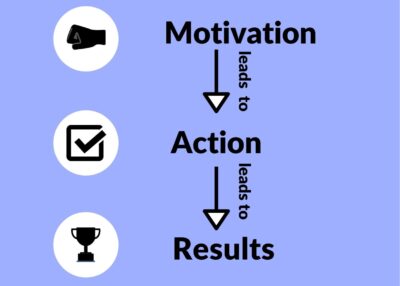
Unfortunately for all of us, this is a drastic oversimplification. It also gives us as individuals way too much credit.
When we talk about self-motivation, we use words like “willpower” and “self-discipline” to describe our pursuits. (It’s like our go-getter team. Motivators Team, assemble!)
In doing so, our culture has made us take ownership of these words as personal qualities. We praise successful people for their willpower and self-discipline. The narrative writes itself: They wanted something, so they did something, so they achieved something. Go them!
Conversely, if we fail, it’s because we lack the self-motivation or willpower. Oh, that person didn’t have the willpower to stick it out. They must not have wanted it badly enough. (And then this failure results in shame, further damages our self-image, and inspires a vicious cycle.)
I mean, if wanting something was enough, I’d be a millionaire on a lake house with a personal masseuse on call. (For the record, I’m not a millionaire on a lake house with a personal masseuse on call; just in case you were wondering.)
Self-motivation is not merely about wanting something.
This seemingly simple sentiment contains a lot of power. And understanding it can set you free.
.
Why this definition of self-motivation is damaging
Humans lack self-awareness on a colossal scale. We think that we know what’s going on with our thoughts and actions. We also think we’re in control.
In reality, emotions drive our thoughts just like candy drives a three-year-old on Halloween. Divided attention, spontaneous distractions, and rapidly changing feelings. Oh, and we often will experience the same inevitable crash.
This lack of discipline is because our emotional center is at the base of our brains. Even though our thoughts feel stable, they’re actually at the mercy of our feelings. (Which are, in turn, driven by a whole slew of other chemical reactions.)

What does this have to do with steps to self-motivation?
If our thoughts were in control, our simple definition or self-motivation might work. We want something, so therefore we do it. This progression makes logical sense.
Our emotional wiring, however, is anything but logical. Our survival instincts kick in. And the once super-helpful processes now make it challenging to change.
We’re driven by seeking pleasure and avoiding pain, even when it’s not good for us overall. We crave certainty and avoid unfamiliar situations. Our brain establishes routines and shortcuts to help us handle information, but ultimately this limits our ability for new experiences.
.
Three Steps to Self-Motivation to Overcome these challenges
We can’t change our brain functions any more than we can change the weather. (Next time you attempt to change your brain, I also want you to go outside and scream at the clouds to go away. You’ll get the equivalent results.)
We can, however, use what we know about our brain wiring to be more successful.
self-motivation requires three elements to work:
- The value we put in our desired change.
- The belief we have that the behaviors will help achieve the change.
- The belief we have in ourselves to follow through with these actions.
Let’s talk about each one in turn.
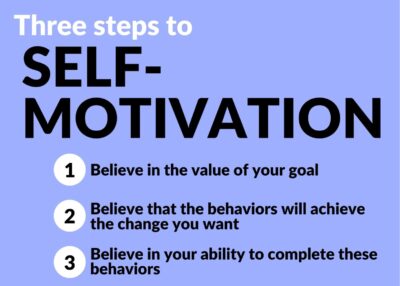
.
The first step to self-motivation: How much value do you put into your desired change?
There’s still an element of “wanting” in self-motivation, and this is it. We’re never going to do something that we don’t think is important. (Especially if it’s hard or unpleasurable.)
I’m sure you’ve all had momentary whims in our life. Wouldn’t it be fun to try yoga? How fun would it be to learn a new language? These whims rarely result in actual change. That’s because they’re not rooted in any value.
At least once a month, I fantasize about learning Spanish. I know there’d be situations in my life where it’d be useful. However, at present, this goal isn’t essential to me. Yes, I’d love to know Spanish. But it won’t change my life and doesn’t excite me.
Until this attitude changes, I’ll never achieve it as a goal.
To be motivated, you first must believe in the importance of the change you want to make.
To do so, you want to ask yourself questions like:
- How much do you believe in your goal?
- How important is it to you?
- How much does it align with your values?
Reminding yourself of this “why” behind your self-motivation is essential in helping you stay the course.
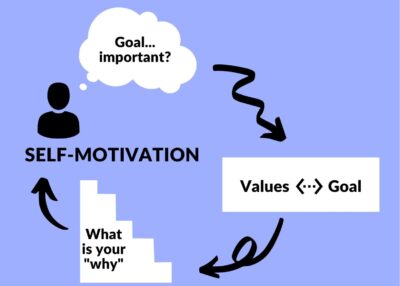
.
The second step to self-motivation: How much do you believe the behaviors will help you achieve the change you want?
Once you’ve established that your goal is important to you, you must shift your focus to the specific behaviors that will help you achieve it. Think of this step as the “how” to your “why.”
I want you to think back to when you did something that felt like “busy work.” Maybe it was in school or at your job. Wherever it was, you didn’t believe that what you were doing had any purpose in what you were trying to achieve.
How motivated were you to finish it?
For these scenarios, you might have had external rewards that pulled you through the task (such as earning a good grade or promotion). For our own goals, however, we rarely have external rewards.
Our self-motivation wavers when we don’t see how our behaviors can help us achieve our desired goals.
For example, let’s say Shayla wants to learn to cook. She already established to herself that the goal is essential. Her chef friend sent her ten different cookbooks and instructed her to read them cover-to-cover.
Shayla eagerly dives into reading, and she creates a habit of reading them before bed. After a week, however, she begins to lose the self-motivation to read. Does she not care about her goal anymore?
Here is where our second step to self-motivation comes in. Shayla is beginning to realize (although she may not be aware of it) that reading cookbooks doesn’t feel like it’s helping her. Her lack of self-motivation isn’t willpower, but instead in this underlying understanding.
We must believe that our actions are helping us get closer to our goal.
To be more intentional and self-aware with this step, ask yourself:
- How much do you believe in the process you’ve created?
- Do the methods convince you of their worthiness? Will they help you achieve your goal?
- What steps might be more effective in achieving your goal?
For our cooking example, Shayla might find her self-motivation skyrocket if she moves away from reading and into the kitchen. We must continuously evaluate the behaviors that we’re engaging in to achieve our goals.
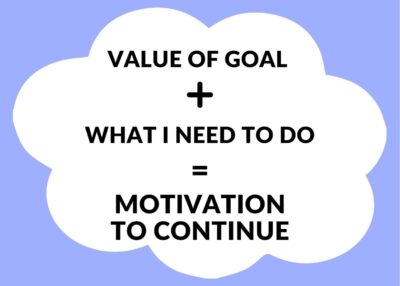
.
The third step to self-motivation: How much do you believe in your ability to stick with the behaviors that will help you reach your goal?
We don’t like to fail. We also don’t like to waste time, invest in something that won’t pay off, or struggle in moments of uncertainty. All of these things make us feel vulnerable.
Often, the behaviors necessary to reach our goal are unpleasant. At the very least, they require us to enact a new routine or behavior that we’re not used to doing. (Remember how our brain creates routines? This makes it tough to break an established habit or start a brand new one.)
That’s why the third step to self-motivation has to do with our belief in ourselves.
Let’s say Tommy wants to become a muscular, six-packed specimen (his words, not mine (yes, yes, he is fictional)). He knows it will require a daily trip to the gym, as well as a whole new diet. His health goal is important to him, and Tommy believes the workout plan will get him there. But as week one goes by, he finds it harder and harder to get to the gym. Why?
His self-motivation dipped because he doesn’t believe in his ability to follow through with his plan. Going to the gym every day? Completely changing his diet? These actionable behaviors already feel exhausting to him.
Until Tommy’s self-belief aligns with his goal-belief, he’ll struggle with this step to self-motivation.
When you’re considering what you must do achieve a goal, ask yourself:
- How confident are you that you can carry out these behaviors?
- How likely is it that you will stick with them?
- How much do you believe in your ultimate success?
A less-than-favorable answer to any of these questions doesn’t mean that you should give up. Instead, it means that you should readjust your process and your mindset.
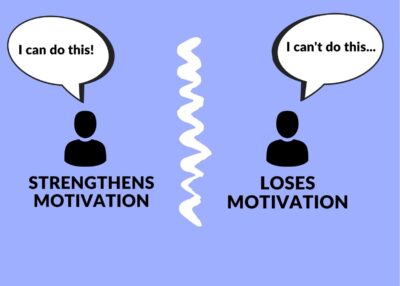
.
Behaviors Change our Self-Perception (and, in turn, our steps to self-motivation)
If you haven’t picked up on it yet, we subconsciously get in our own way… a lot. (Like, a lot a lot). Another human tendency that holds us back? Our desire for clean, predictable labels.
Identity is a complicated concept that I won’t attempt to dive into now. For the sake of our third step to self-motivation, the critical piece to understand is this:
We often default to predictable labels for ourselves, even if they’re negative. The comfort of knowing who we are, even if it’s an inferior version, feels safer than challenging ourselves to change. (Not knowing makes us feel vulnerable, which is hard for us.)
This lack of belief in ourselves is most often where people fail in self-motivation. They see the value in their goal, they understand the steps to get there, but then, they don’t believe in their ability to change.
Identity is not fixed, nor does it require drastic life changes to be altered. The problem is that many of us believe we need to think our way to a changed self-perception.
Instead, we can shape our identity every day through our actions.
Our behaviors can help us change our identities, and in turn, increase our self-motivation. Dr. Benjamin Hardy calls this self-signaling.
For example, Tommy thinks he’s not someone who can go to the gym every day. He holds onto this label of “non-exercising, non-gym-going person” because, through thinking alone, he can’t change it.
However, if Tommy goes to the gym a few times, his brain has new evidence. He’s no longer a “non-exercising” guy. Now, he’s a guy that exercises a couple of times a week. Give it a few more times, and Tommy will start to see himself as a gym-goer.
The belief in yourself is the most challenging piece of self-motivation. That’s why it’s so critical to reflect on your behaviors. By calling attention to your actions, you can begin to encourage your brain to see yourself differently.
Eventually, you’ll build up that third step to self-motivation: how much you believe in your ability to accomplish your goals.
.Conclusion
Despite popular belief, our internal self-motivation relies on more than merely wanting something. Our emotions and essential brain functions hold us back from change much more than we give them credit for.
self-motivation, therefore, is a complex idea. It requires three elements to lead us to success with our goals:
- The value we put in our desired change.
- The belief we have that the behaviors will help achieve the change.
- The belief we have in ourselves to follow through with these actions.
We must practice self-awareness to evaluate where we fall concerning these values and beliefs for each step to self-motivation. Then, we must continually reassess our self-motivation in the context of these three requirements.




Hello – Great Post!
Do you by any chance know if Vince Sant’s VShred guide is any good?
It looks like V Shred may well be a good option but after reading https://vshredreview.com/ I’m having second thoughts
I’m looking for reviews on good workouts other mothers have bought online to tone their bodies. I would love to get my bikini body back.
Much appreciated
Samantha G.
Thanks for commenting! I don’t know anything about Vshred unfortunately. I’m a big Insanity fan with Sean T, which is under the Beachbody organization. I think they have a bunch of different workouts- it’s the type of thing you can do as much or as little as you want and still get something out of it. Good luck on your journey, and don’t underestimate these three steps! I try to come back to them when I’m doing a new goal (especially when my motivation starts to wane after about a week). I’d recommend reading my post on how to design your environment too- it might help!